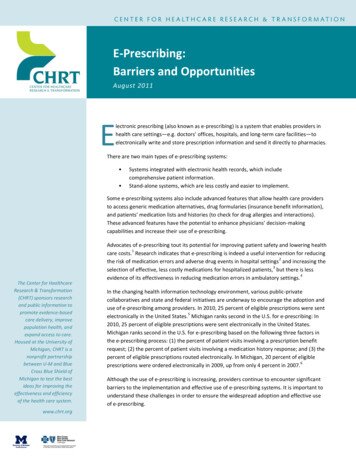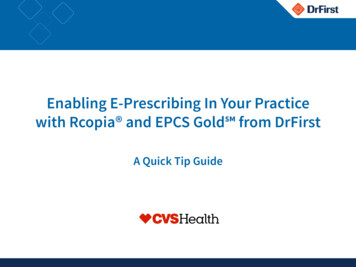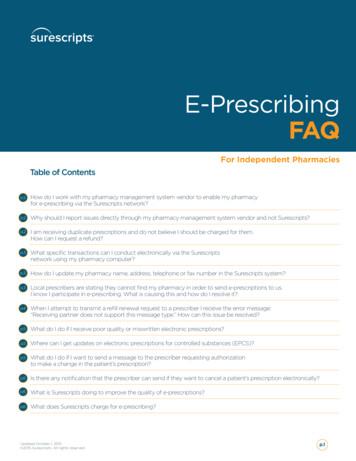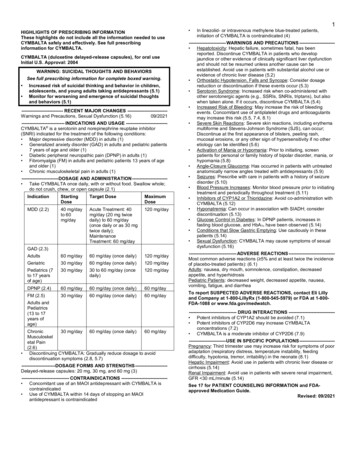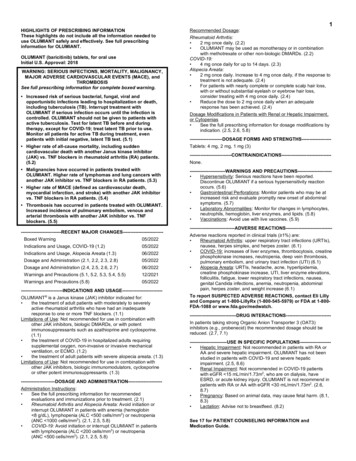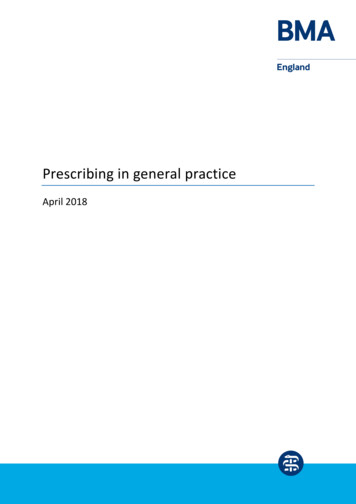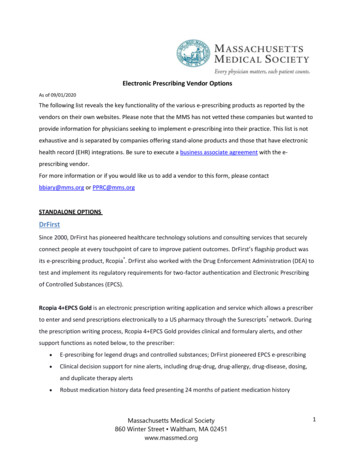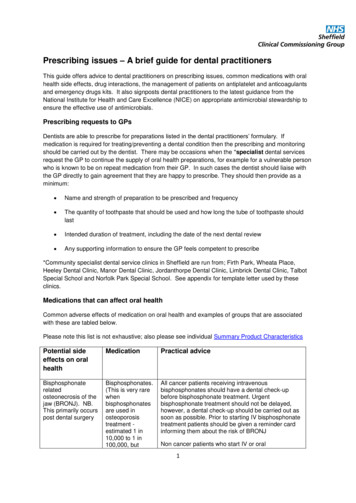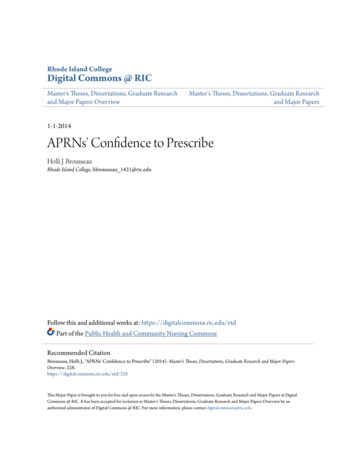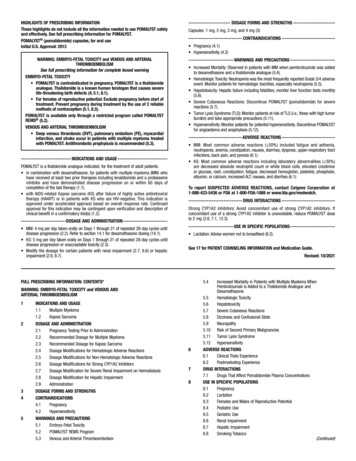
Transcription
HIGHLIGHTS OF PRESCRIBING INFORMATIONThese highlights do not include all the information needed to use POMALYST safelyand effectively. See full prescribing information for POMALYST.POMALYST (pomalidomide) capsules, for oral useInitial U.S. Approval: 2013------------------------- DOSAGE FORMS AND STRENGTHS--------------------------WARNING: EMBRYO-FETAL TOXICITY and VENOUS AND ARTERIALTHROMBOEMBOLISMSee full prescribing information for complete boxed warningEMBRYO-FETAL TOXICITY POMALYST is contraindicated in pregnancy. POMALYST is a thalidomideanalogue. Thalidomide is a known human teratogen that causes severelife-threatening birth defects (4, 5.1, 8.1). For females of reproductive potential: Exclude pregnancy before start oftreatment. Prevent pregnancy during treatment by the use of 2 reliablemethods of contraception (5.1, 8.3).POMALYST is available only through a restricted program called POMALYSTREMS (5.2).VENOUS AND ARTERIAL THROMBOEMBOLISM Deep venous thrombosis (DVT), pulmonary embolism (PE), myocardialinfarction, and stroke occur in patients with multiple myeloma treatedwith POMALYST. Antithrombotic prophylaxis is recommended (5.3).--------------------------- WARNINGS AND ------------------- INDICATIONS AND USAGE------------------------------POMALYST is a thalidomide analogue indicated, for the treatment of adult patients: in combination with dexamethasone, for patients with multiple myeloma (MM) whohave received at least two prior therapies including lenalidomide and a proteasomeinhibitor and have demonstrated disease progression on or within 60 days ofcompletion of the last therapy (1.1). with AIDS-related Kaposi sarcoma (KS) after failure of highly active antiretroviraltherapy (HAART) or in patients with KS who are HIV-negative. This indication isapproved under accelerated approval based on overall response rate. Continuedapproval for this indication may be contingent upon verification and description ofclinical benefit in a confirmatory trial(s) (1.2).---------------------------DOSAGE AND ADMINISTRATION--------------------------- MM: 4 mg per day taken orally on Days 1 through 21 of repeated 28-day cycles untildisease progression (2.2). Refer to section 14.1 for dexamethasone dosing (14.1). KS: 5 mg per day taken orally on Days 1 through 21 of repeated 28-day cycles untildisease progression or unacceptable toxicity (2.3). Modify the dosage for certain patients with renal impairment (2.7, 8.6) or hepaticimpairment (2.8, 8.7).Capsules: 1 mg, 2 mg, 3 mg, and 4 mg (3)-------------------------------- CONTRAINDICATIONS-------------------------------- Pregnancy (4.1) Hypersensitivity (4.2) Increased Mortality: Observed in patients with MM when pembrolizumab was addedto dexamethasone and a thalidomide analogue (5.4). Hematologic Toxicity: Neutropenia was the most frequently reported Grade 3/4 adverseevent. Monitor patients for hematologic toxicities, especially neutropenia (5.5). Hepatotoxicity: Hepatic failure including fatalities; monitor liver function tests monthly(5.6). Severe Cutaneous Reactions: Discontinue POMALYST (pomalidomide) for severereactions (5.7). Tumor Lysis Syndrome (TLS): Monitor patients at risk of TLS (i.e., those with high tumorburden) and take appropriate precautions (5.11). Hypersensitivity: Monitor patients for potential hypersensitivity. Discontinue POMALYSTfor angioedema and anaphylaxis (5.12).-------------------------------- ADVERSE REACTIONS-------------------------------- MM: Most common adverse reactions ( 30%) included fatigue and asthenia,neutropenia, anemia, constipation, nausea, diarrhea, dyspnea, upper-respiratory tractinfections, back pain, and pyrexia (6.1). KS: Most common adverse reactions including laboratory abnormalities ( 30%)are decreased absolute neutrophil count or white blood cells, elevated creatinineor glucose, rash, constipation, fatigue, decreased hemoglobin, platelets, phosphate,albumin, or calcium, increased ALT, nausea, and diarrhea (6.1).To report SUSPECTED ADVERSE REACTIONS, contact Celgene Corporation at1-888-423-5436 or FDA at 1‑800-FDA-1088 or --- DRUG INTERACTIONS--------------------------------Strong CYP1A2 Inhibitors: Avoid concomitant use of strong CYP1A2 inhibitors. Ifconcomitant use of a strong CYP1A2 inhibitor is unavoidable, reduce POMALYST doseto 2 mg (2.6, 7.1, 12.3).---------------------------USE IN SPECIFIC POPULATIONS--------------------------- Lactation: Advise women not to breastfeed (8.2).See 17 for PATIENT COUNSELING INFORMATION and Medication Guide.Revised: 10/2021FULL PRESCRIBING INFORMATION: CONTENTS*5.4WARNING: EMBRYO-FETAL TOXICITY and VENOUS ANDARTERIAL THROMBOEMBOLISM12345INDICATIONS AND USAGE1.1Multiple Myeloma1.2Kaposi SarcomaDOSAGE AND ADMINISTRATION2.1Pregnancy Testing Prior to Administration2.2Recommended Dosage for Multiple Myeloma2.3Recommended Dosage for Kaposi Sarcoma2.4Dosage Modifications for Hematologic Adverse Reactions2.5Dosage Modifications for Non-Hematologic Adverse Reactions2.6Dosage Modifications for Strong CYP1A2 Inhibitors2.7Dosage Modification for Severe Renal Impairment on Hemodialysis2.8Dosage Modification for Hepatic Impairment2.9AdministrationDOSAGE FORMS AND itivityWARNINGS AND PRECAUTIONS5.1Embryo-Fetal Toxicity5.2POMALYST REMS Program5.3Venous and Arterial Thromboembolism678Increased Mortality in Patients with Multiple Myeloma WhenPembrolizumab Is Added to a Thalidomide Analogue andDexamethasone5.5Hematologic Toxicity5.6Hepatotoxicity5.7Severe Cutaneous Reactions5.8Dizziness and Confusional State5.9Neuropathy5.10 Risk of Second Primary Malignancies5.11 Tumor Lysis Syndrome5.12 HypersensitivityADVERSE REACTIONS6.1Clinical Trials Experience6.2Postmarketing ExperienceDRUG INTERACTIONS7.1Drugs That Affect Pomalidomide Plasma ConcentrationsUSE IN SPECIFIC POPULATIONS8.1Pregnancy8.2Lactation8.3Females and Males of Reproductive Potential8.4Pediatric Use8.5Geriatric Use8.6Renal Impairment8.7Hepatic Impairment8.8Smoking Tobacco(Continued)
FULL PRESCRIBING INFORMATION: CONTENTS* (Continued)101112OVERDOSAGEDESCRIPTIONCLINICAL PHARMACOLOGY12.1 Mechanism of Action12.2 Pharmacodynamics12.3 PharmacokineticsNONCLINICAL TOXICOLOGY13.1 Carcinogenesis, Mutagenesis, Impairment of Fertility1314151617CLINICAL STUDIES14.1 Multiple Myeloma14.2 Kaposi SarcomaREFERENCESHOW SUPPLIED/STORAGE AND HANDLINGPATIENT COUNSELING INFORMATION*Sections or subsections omitted from the full prescribing information are not listed.FULL PRESCRIBING INFORMATIONWARNING: EMBRYO-FETAL TOXICITY and VENOUS AND ARTERIALTHROMBOEMBOLISMEmbryo-Fetal Toxicity POMALYST is contraindicated in pregnancy. POMALYST is a thalidomideanalogue. Thalidomide is a known human teratogen that causes severebirth defects or embryo-fetal death. In females of reproductive potential,obtain 2 negative pregnancy tests before starting POMALYST treatment. Females of reproductive potential must use 2 forms of contraception orcontinuously abstain from heterosexual sex during and for 4 weeks afterstopping POMALYST treatment [see Contraindications (4), Warnings andPrecautions (5.1) and Use in Specific Populations (8.1, 8.3)].POMALYST is only available through a restricted distribution program calledPOMALYST REMS [see Warnings and Precautions (5.2)].Venous and Arterial Thromboembolism Deep venous thrombosis (DVT), pulmonary embolism (PE), myocardialinfarction, and stroke occur in patients with multiple myeloma treatedwith POMALYST. Prophylactic antithrombotic measures were employedin clinical trials. Thromboprophylaxis is recommended, and the choice ofregimen should be based on assessment of the patient’s underlying riskfactors [see Warnings and Precautions (5.3)].1INDICATIONS AND USAGE1.1Multiple MyelomaPOMALYST (pomalidomide), in combination with dexamethasone, is indicated for adultpatients with multiple myeloma (MM) who have received at least two prior therapiesincluding lenalidomide and a proteasome inhibitor and have demonstrated diseaseprogression on or within 60 days of completion of the last therapy.1.2Kaposi SarcomaPOMALYST is indicated for the treatment of: Adult patients with AIDS-related Kaposi sarcoma (KS) after failure of highly activeantiretroviral therapy (HAART). Kaposi sarcoma (KS) in adult patients who are HIV-negative.This indication is approved under accelerated approval based on overall response rate[see Clinical Studies (14.2)]. Continued approval for this indication may be contingentupon verification and description of clinical benefit in a confirmatory trial(s).2DOSAGE AND ADMINISTRATION2.1Pregnancy Testing Prior to AdministrationFemales of reproductive potential must have negative pregnancy testing and usecontraception methods before initiating POMALYST [see Warnings and Precautions (5.1)and Use in Specific Populations (8.1, 8.3)].2.2Recommended Dosage for Multiple MyelomaThe recommended dosage of POMALYST is 4 mg once daily orally with or without foodon Days 1 through 21 of each 28-day cycle until disease progression. Give POMALYST incombination with dexamethasone [see Clinical Studies (14.1)].2.3Recommended Dosage for Kaposi SarcomaThe recommended dosage of POMALYST is 5 mg once daily taken orally with or withoutfood on Days 1 through 21 of each 28‑day cycle until disease progression or unacceptabletoxicity. Continue HAART as HIV treatment in patients with AIDS-related Kaposi sarcoma(KS) [see Clinical Studies (14.2)].2.4Dosage Modifications for Hematologic Adverse ReactionsMultiple Myeloma: Dosage Modifications for Hematologic Adverse ReactionsInitiate a new cycle of POMALYST in patients with multiple myeloma (MM) when theneutrophil count is at least 500 per mcL and the platelet count is at least 50,000 per mcL.Dosage modification for POMALYST (pomalidomide) for hematologic adverse reactions inpatients with MM are summarized in Table 1.Table 1:Dosage Modifications for POMALYST for Hematologic in MMAdverse ReactionNeutropenia[see Warnings andPrecautions (5.5)]Severity ANC less than500 per mcL orfebrile neutropenia(fever greater thanor equal to 38.5 Cand ANC less than1,000 per mcL) For each subsequentdrop of ANC less than500 per mcLDosage Modification Withhold POMALYST until ANC isgreater than or equal to 500 per mcL;follow CBC weekly. Resume POMALYST dose at 1 mg lessthan the previous dose.* Withhold POMALYST until ANC isgreater than or equal to 500 mcL. Resume POMALYST dose at 1 mg lessthan the previous dose.*Thrombocytopenia Platelets less than Withhold POMALYST until platelets are[see Warnings and25,000 per mcLgreater than or equal to 50,000 perPrecautions (5.5)]mcL; follow CBC weekly. Resume POMALYST dose at 1 mg lessthan the previous dose* For each subsequent Withhold POMALYST until plateletsdrop of platelets lessare greater than or equal tothan 25,000 per mcL50,000 per mcL. Resume POMALYST at 1 mg less thanthe previous dose** Permanently discontinue POMALYST if unable to tolerate 1 mg once daily.ANC absolute neutrophil countKaposi Sarcoma: Dosage Modifications for Hematologic Adverse ReactionsInitiate a new cycle of POMALYST in patients with KS when the neutrophil count is at least1000 per mcL and the platelet count is at least 75,000 per mcL.Dose modifications for POMALYST for hematologic adverse reactions in patients with KSare summarized in Table 2.Table 2:Dosage Modifications for POMALYST for Hematologic AdverseReactions in KSAdverse ReactionNeutropenia[see Warnings andPrecautions (5.5)]SeverityDosage ModificationANC 500 to less than Day 1 of cycle1,000 per mcL Withhold POMALYST until ANC isgreater than or equal to 1,000 permcL. Resume POMALYST at the same dose.During cycle Continue POMALYST at the currentdose.ANC less than 500 per Withhold POMALYST until ANCis greater than or equal to 1,000 permcLmcL. Resume POMALYST at the same dose.(Continued)
POMALYST (pomalidomide)POMALYST (pomalidomide)Table 2:Dosage Modifications for POMALYST for Hematologic Adverse(Continued) Reactions in KSAdverse ReactionFebrile Neutropenia[see Warnings andPrecautions (5.5)]Thrombocytopenia[see Warnings andPrecautions (5.5)]SeverityDosage ModificationANC less than 1,000 Withhold POMALYST until ANC isper mcL and singlegreater than or equal to 1,000 pertemperature greater thanmcL.or equal to 38.3 C Resume POMALYST at dose 1 mg lessthan the previous dose.*orANC less than 1,000per mcL and sustainedtemperature greaterthan or equal to 38 C formore than 1 hourPlatelet countDay 1 of cycle25,000 to less than Withhold POMALYST until platelet count50,000 per mcLis greater than or equal to 50,000per mcL. Resume POMALYST at the same dose.During cycle: Continue POMALYST at the currentdose.Permanently discontinue POMALYST.Platelet count less than25,000 per mcL* Permanently discontinue POMALYST if unable to tolerate 1 mg once daily.ANC absolute neutrophil count2.5Dosage Modifications for Non-Hematologic Adverse ReactionsPermanently discontinue POMALYST for angioedema, anaphylaxis, Grade 4 rash,skin exfoliation, bullae, or any other severe dermatologic reaction [See Warnings andPrecautions (5.7, 5.12)].For other Grade 3 or 4 toxicities, hold treatment and restart treatment at 1 mg less thanthe previous dose when toxicity has resolved to less than or equal to Grade 2 at thephysician’s discretion.2.6Dosage Modifications for Strong CYP1A2 InhibitorsAvoid concomitant use of POMALYST with strong CYP1A2 inhibitors. If concomitant useof a strong CYP1A2 inhibitor is unavoidable, reduce POMALYST dose to 2 mg [see DrugInteractions (7.1) and Clinical Pharmacology (12.3)].2.7Dosage Modification for Severe Renal Impairment on HemodialysisTake POMALYST after completion of dialysis procedure on hemodialysis days [see Use inSpecific Populations (8.6) and Clinical Pharmacology (12.3)]. 2.8For patients with MM with severe renal impairment requiring dialysis, reduce therecommended dosage to 3 mg orally daily.For patients with KS with severe renal impairment requiring dialysis, reduce therecommended dosage to 4 mg orally daily.Dosage Modification for Hepatic ImpairmentMultiple MyelomaFor patients with MM with mild or moderate hepatic impairment (Child-Pugh A or B),reduce the recommended dosage to 3 mg orally daily.For patients with MM with severe hepatic impairment (Child-Pugh C), reduce therecommended dosage to 2 mg [see Use in Specific Populations (8.7) and ClinicalPharmacology (12.3)].Kaposi SarcomaFor patients with KS with mild, moderate, or severe hepatic impairment (Child-PughA, B, or C), reduce the recommended dosage to 3 mg orally daily [see Use in SpecificPopulations (8.7) and Clinical Pharmacology nancyPOMALYST is contraindicated in females who are pregnant. POMALYST can causefetal harm when administered to a pregnant female [see Warnings and Precautions(5.1) and Use in Specific Populations (8.1)]. Pomalidomide is a thalidomide analogueand is teratogenic in both rats and rabbits when administered during the period oforganogenesis. If the patient becomes pregnant while taking this drug, the patient shouldbe apprised of the potential risk to a fetus.4.2HypersensitivityPOMALYST is contraindicated in patients who have demonstrated severe hypersensitivity(e.g., angioedema, anaphylaxis) to pomalidomide or any of the excipients [see Warningsand Precautions (5.7), Description (11)].5WARNINGS AND PRECAUTIONS5.1Embryo-Fetal ToxicityPOMALYST is a thalidomide analogue and is contraindicated for use during pregnancy.Thalidomide is a known human teratogen that causes severe birth defects or embryofetal death [see Use in Specific Populations (8.1)]. POMALYST is only available through thePOMALYST REMS program [see Warnings and Precautions (5.2)].Females of Reproductive PotentialFemales of reproductive potential must avoid pregnancy for at least 4 weeks beforebeginning POMALYST therapy, during therapy, during dose interruptions and for at least4 weeks after completing therapy.Females must commit either to abstain continuously from heterosexual sexual intercourseor to use 2 methods of reliable birth control, beginning 4 weeks prior to initiatingtreatment with POMALYST, during therapy, during dose interruptions, and continuing for4 weeks following discontinuation of POMALYST therapy.Two negative pregnancy tests must be obtained prior to initiating therapy. The first testshould be performed within 10-14 days and the second test within 24 hours prior toprescribing POMALYST therapy and then weekly during the first month, then monthlythereafter in females with regular menstrual cycles, or every 2 weeks in females withirregular menstrual cycles [see Use in Specific Populations (8.3)].MalesPomalidomide is present in the semen of patients receiving the drug. Therefore, malesmust always use a latex or synthetic condom during any sexual contact with females ofreproductive potential while taking POMALYST and for up to 4 weeks after discontinuingPOMALYST, even if they have undergone a successful vasectomy. Male patients takingPOMALYST must not donate sperm [see Use in Specific Populations (8.3)].Blood DonationPatients must not donate blood during treatment with POMALYST and for 4 weeksfollowing discontinuation of the drug because the blood might be given to a pregnantfemale patient whose fetus must not be exposed to POMALYST.5.2POMALYST REMS ProgramBecause of the embryo-fetal risk [see Warnings and Precautions (5.1)], POMALYSTis available only through a restricted program under a Risk Evaluation and MitigationStrategy (REMS), the “POMALYST REMS” program.Required components of the POMALYST REMS program include the following: Prescribers must be certified with the POMALYST REMS program by enrolling andcomplying with the REMS requirements. Patients must sign a Patient-Physician Agreement Form and comply with the REMSrequirements. In particular, female patients of reproductive potential who are notpregnant must comply with the pregnancy testing and contraception requirements[see Use in Specific Populations (8.3)] and males must comply with contraceptionrequirements [see Use in Specific Populations (8.3)]. Pharmacies must be certified with the POMALYST REMS program, must onlydispense to patients who are authorized to receive POMALYST and comply with REMSrequirements.Swallow capsules whole with water. Do not break, chew, or open the capsules.Further information about the POMALYST REMS program is available atwww.celgeneriskmanagement.com or by telephone at 1-888-423-5436.POMALYST may be taken with or without food.5.33Venous thromboembolic events (deep venous thrombosis and pulmonary embolism) andarterial thromboembolic events (myocardial infarction and stroke) have been observedin patients treated with POMALYST. In Trial 2, where anticoagulant therapies weremandated, thromboembolic events occurred in 8.0% of patients treated with POMALYSTand low dose-dexamethasone (Low-dose Dex), and 3.3% of patients treated withhigh-dose dexamethasone. Venous thromboembolic events (VTE) occurred in 4.7% ofpatients treated with POMALYST and Low-dose Dex, and 1.3% of patients treated withhigh-dose dexamethasone. Arterial thromboembolic events include terms for arterialthromboembolic events, ischemic cerebrovascular conditions, and ischemic heart disease.Arterial thromboembolic events occurred in 3.0% of patients treated with POMALYST andLow-dose Dex, and 1.3% of patients treated with high-dose dexamethasone.DOSAGE FORMS AND STRENGTHS Capsules:1 mg, dark blue opaque cap and yellow opaque body, imprinted“POML” on the cap in white ink and “1 mg” on the body in black ink2 mg, dark blue opaque cap and orange opaque body, imprinted “POML” on thecap and “2 mg” on the body in white ink3 mg, dark blue opaque cap and green opaque body, imprinted “POML” on thecap and “3 mg” on the body in white ink4 mg, dark blue opaque cap and blue opaque body, imprinted “POML” on the capand “4 mg” on the body in white inkVenous and Arterial Thromboembolism
POMALYST (pomalidomide)Patients with known risk factors, including prior thrombosis, may be at greater risk, andactions should be taken to try to minimize all modifiable factors (e.g., hyperlipidemia,hypertension, smoking). Thromboprophylaxis is recommended, and the choice of regimenshould be based on assessment of the patient’s underlying risk factors.5.4Increased Mortality in Patients with Multiple Myeloma WhenPembrolizumab Is Added to a Thalidomide Analogue and DexamethasoneIn two randomized clinical trials in patients with MM, the addition of pembrolizumab to athalidomide analogue plus dexamethasone, a use for which no PD-1 or PD-L1 blockingantibody is indicated, resulted in increased mortality. Treatment of patients with MM witha PD-1 or PD-L1 blocking antibody in combination with a thalidomide analogue plusdexamethasone is not recommended outside of controlled clinical trials.5.5Hematologic ToxicityMultiple MyelomaIn trials 1 and 2 in patients who received POMALYST Low-dose Dex, neutropenia wasthe most frequently reported Grade 3 or 4 adverse reaction, followed by anemia andthrombocytopenia. Neutropenia of any grade was reported in 51% of patients in both trials.The rate of Grade 3 or 4 neutropenia was 46%. The rate of febrile neutropenia was 8%.Monitor patients for hematologic toxicities, especially neutropenia. Monitor complete bloodcounts weekly for the first 8 weeks and monthly thereafter. Patients may require doseinterruption and/or modification [see Dosage and Administration (2.4)].Kaposi SarcomaIn Trial 12-C-0047, hematologic toxicities were the most common (all grades andGrade 3 or 4) adverse reactions [see Adverse Reactions (6.1)]. Fifty percent of patients hadGrade 3 or 4 neutropenia. Monitor patients for hematologic toxicities, especially decreasedneutrophils. Monitor complete blood counts every 2 weeks for the first 12 weeks andmonthly thereafter. Withhold, reduce the dose, or permanently discontinue POMALYSTbased on the severity of the reaction [see Dosage and Administration (2.4)].5.6HepatotoxicityHepatic failure, including fatal cases, has occurred in patients treated with POMALYST.Elevated levels of alanine aminotransferase and bilirubin have also been observed inpatients treated with POMALYST. Monitor liver function tests monthly. Stop POMALYSTupon elevation of liver enzymes and evaluate. After return to baseline values, treatment ata lower dose may be considered.5.7Severe Cutaneous ReactionsSevere cutaneous reactions including Stevens-Johnson syndrome (SJS), toxic epidermalnecrolysis (TEN), and drug reaction with eosinophilia and systemic symptoms (DRESS)have been reported. DRESS may present with a cutaneous reaction (such as rashor exfoliative dermatitis), eosinophilia, fever, and/or lymphadenopathy with systemiccomplications such as hepatitis, nephritis, pneumonitis, myocarditis, and/or pericarditis.These reactions can be fatal. Consider POMALYST interruption or discontinuation forGrade 2 or 3 skin rash. Permanently discontinue POMALYST for Grade 4 rash, exfoliativeor bullous rash, or for other severe cutaneous reactions such as SJS, TEN or DRESS [seeDosage and Administration (2.5)].5.8Dizziness and Confusional StateIn trials 1 and 2 in patients who received POMALYST Low-dose Dex, 14% of patientsexperienced dizziness and 7% of patients experienced a confusional state; 1% ofpatients experienced Grade 3 or 4 dizziness, and 3% of patients experienced Grade 3 or4 confusional state. Instruct patients to avoid situations where dizziness or confusionalstate may be a problem and not to take other medications that may cause dizziness orconfusional state without adequate medical advice.5.9NeuropathyIn trials 1 and 2 in patients who received POMALYST Low-dose Dex, 18% of patientsexperienced neuropathy, with approximately 12% of the patients experiencing peripheralneuropathy. Two percent of patients experienced Grade 3 neuropathy in trial 2. There wereno cases of Grade 4 neuropathy adverse reactions reported in either trial.5.10Risk of Second Primary MalignanciesCases of acute myelogenous leukemia have been reported in patients receivingPOMALYST as an investigational therapy outside of MM.5.11Tumor Lysis SyndromeTumor lysis syndrome (TLS) may occur in patients treated with POMALYST. Patients atrisk for TLS are those with high tumor burden prior to treatment. These patients should bemonitored closely and appropriate precautions taken.5.12HypersensitivityHypersensitivity, including angioedema, anaphylaxis, and anaphylactic reactions toPOMALYST have been reported. Permanently discontinue POMALYST for angioedema oranaphylaxis [see Dosage and Administration (2.5)].6ADVERSE REACTIONSThe following clinically significant adverse reactions are described in detail in otherlabeling sections:POMALYST (pomalidomide) Embryo-Fetal Toxicity [see Warnings and Precautions (5.1, 5.2)]Venous and Arterial Thromboembolism [see Warnings and Precautions (5.3)]Increased Mortality in Patients with Multiple Myeloma When PembrolizumabIs Added to a Thalidomide Analogue and Dexamethasone [see Warnings andPrecautions (5.4)]Hematologic Toxicity [see Warnings and Precautions (5.5)]Hepatotoxicity [see Warnings and Precautions (5.6)]Severe Cutaneous Reactions [see Warnings and Precautions (5.7)]Dizziness and Confusional State [see Warnings and Precautions (5.8)]Neuropathy [see Warnings and Precautions (5.9)]Risk of Second Primary Malignancies [see Warnings and Precautions (5.10)]Tumor Lysis Syndrome [see Warnings and Precautions (5.11)]Hypersensitivity [see Warnings and Precautions (5.12)]6.1Clinical Trials ExperienceBecause clinical trials are conducted under widely varying conditions, adverse reactionrates observed in the clinical trials of a drug cannot be directly compared to rates in theclinical trials of another drug and may not reflect the rates observed in practice.Multiple Myeloma (MM)In Trial 1, data were evaluated from 219 patients (safety population) who receivedtreatment with POMALYST Low-dose Dex (112 patients) or POMALYST alone (107patients). Median number of treatment cycles was 5. Sixty-seven percent of patients in thestudy had a dose interruption of either drug due to adverse reactions. Forty-two percentof patients in the study had a dose reduction of either drug due to adverse reactions. Thediscontinuation rate due to adverse reactions was 11%.In Trial 2, data were evaluated from 450 patients (safety population) who receivedtreatment with POMALYST Low-dose Dex (300 patients) or High-dose Dexamethasone(High-dose Dex) (150 patients). The median number of treatment cycles for the POMALYST Low-dose Dex arm was 5. In the POMALYST Low-dose Dex arm, 67% of patientshad a dose interruption of POMALYST, the median time to the first dose interruption ofPOMALYST was 4.1 weeks. Twenty-seven percent of patients had a dose reduction ofPOMALYST, the median time to the first dose reduction of POMALYST was 4.5 weeks.Eight percent of patients discontinued POMALYST due to adverse reactions.Tables 3 and 4 summarize the adverse reactions reported in Trials 1 and 2, respectively.Table 3:Adverse Reactions in Any POMALYST Treatment Arm in Trial 1*All Adverse Reactions 10%in Either ArmPOMALYST Low-doseaPOMALYSTDex(N 107)(N 112)107 (100)112 (100)Body SystemAdverse ReactionNumber (%) of patientswith at least oneadverse reactionBlood and lymphatic system disordersNeutropeniab57 (53)55 (49)41 (38)47 (42)Anemiab28 (26)26 (23)ThrombocytopeniabLeukopenia14 (13)22 (20) 10% 10%Febrile neutropeniabLymphopenia4 (4)17 (15)General disorders and administration site conditions62 (58)70 (63) Fatigue and astheniabEdema peripheral27 (25)19 (17)25 (23)36 (32)PyrexiabChills11 (10)14 (13)Gastrointestinal disorders39 (36)27 (24)Nauseab38 (36)41 (37)ConstipationbDiarrhea37 (35)40 (36)15 (14)16 (14)VomitingbGrade 3 or 4 5% in Either ArmPOMALYST Low-dosePOMALYSTDex(N 107)(N 112)98 (92)102 (91)51 (48)25 (23)24 (22)7 (7)6 (6)2 (2)46 (41)24 (21)21 (19)11 (10)3 (3)8 (7)13 (12)0 (0.0) 5%0 (0.0)19 (17)0 (0.0) 5%0 (0.0) 5% 5% 5% 5% 5% 5% 5%0 (0.0)(Continued)
POMALYST (pomalidomide)Table 3:Adverse Reactions in Any POMALYST Treatment Arm in Trial 1*(Continued)All Adverse Reactions 10%Grade 3 or 4in Either Arm 5% in Either ArmPOMALYST POMALYST Low-doseLow-dosePOMALYSTBody SystemPOMALYSTaDexDex(N 107)(N 112)(N 107)(N 112)Adverse ReactionMusculoskeletal and connective tissue disorders37 (35)36 (32)15 (14)11 (10)Back painb Musculoskeletal25 (23)22 (20) 5%0 (0.0)chest painMuscle spasms23 (21)22 (20) 5% 5%Arthralgia18 (17)17 (15) 5% 5%Muscular weakness15 (14)15 (13)6 (6)4 (4)Bone pain13 (12)8 (7) 5% 5%Musculoskeletal pain13 (12)19 (17) 5% 5%Pain in extremity8 (7)16 (14)0 (0.0) 5%Infections and infestations Upper respiratory40 (37)32 (29) 5% 5%tract infection30 (28)38 (34)21 (20)32 (29)Pneumoniab11 (10)19 (17)2 (2)10 (9) Urinary tractinfectionbSepsisb 10% 10%6 (6)5 (4)Metabolism and nutrition disordersDecreased appetite25 (23)21 (19) 5%0 (0.0)23 (21)13 (12)11 (10)1 ( 1)HypercalcemiabHypokalemia13 (12)13 (12) 5% 5%Hyperglycemia12 (11)17 (15) 5% 5%Hyponatremia12 (11)14 (13) 5% 5% 10% 10%5 (4.7)6 (5.4)DehydrationbHypocalcemia6 (6)13 (12)0 (0.0) 5%Respiratory, thoracic and mediastinal disorders38 (36)50 (45)8 (7)14 (13)DyspneabCough18 (17)25 (22)0 (0.0)0 (0.0)Epistaxis18 (17)12 (11) 5%0 (0.0)Productive cough10 (9)14 (13)0 (0.0)0 (0.0)Oropharyngeal pain6 (6)12 (11)0 (0.0)0 (0.0)Nervous system disordersDizziness24 (22)20 (18) 5% 5%Peripheral neuropathy23 (21)20 (18)0 (0.0)0 (0.0)Headache16 (15)15 (13)0 (0.0) 5%Tremor11 (10)15 (13)0 (0.0)0 (0.0)Skin and subcutaneous tissue disordersRash22 (21)18 (16)0 (0.0) 5%Pruritus16 (15)10 (9)0 (0.0)0 (0.0)Dry skin10 (9)12 (11)0 (0.0)0 (0.0)Hyperhidrosis8 (7)18 (16)0 (0.0)0 (0.0)Night sweats5 (5)14 (13)0 (0.0)0 (0.0)Investigations20 (19)11 (10)6 (6)3 (3) Blood creatinineincreasedbWeight decreased16 (15)10 (9)0 (0.0)0 (0.0)Weight increased1 ( 1)12 (11)0 (0.
HIGHLIGHTS OF PRESCRIBING INFORMATION These highlights do not include all the information needed to use POMALYST safely and effectively. See full prescribing information for POMALYST. POMALYST (pomalidomide) capsules, for oral use Initial U.S. Approval: 2013 WARNING: EMBRYO-FETAL TOXICITY and VENOUS AND ARTERIAL THROMBOEMBOLISM
